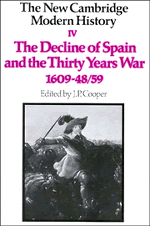Book contents
- Frontmatter
- INTRODUCTORY
- THE CENTRAL CONFLICTS
- THE UNMAKING AND REMAKING OF STATES
- Chapter XV The Spanish peninsula 1598–1648
- Chapter XVI French institutions and society 1610–61
- Chapter XVII The Habsburg lands 1618–57
- Chapter XVIII The fall of the Stuart monarchy
- CHAPTER XIX THE ENDING OF POLISH EXPANSION AND THE SURVIVAL OF RUSSIA
- THE FRONTIERS OF EUROPE
- References
Chapter XVII - The Habsburg lands 1618–57
from THE UNMAKING AND REMAKING OF STATES
Published online by Cambridge University Press: 28 March 2008
- Frontmatter
- INTRODUCTORY
- THE CENTRAL CONFLICTS
- THE UNMAKING AND REMAKING OF STATES
- Chapter XV The Spanish peninsula 1598–1648
- Chapter XVI French institutions and society 1610–61
- Chapter XVII The Habsburg lands 1618–57
- Chapter XVIII The fall of the Stuart monarchy
- CHAPTER XIX THE ENDING OF POLISH EXPANSION AND THE SURVIVAL OF RUSSIA
- THE FRONTIERS OF EUROPE
- References
Summary
At the beginning of the seventeenth century the states of the House of Habsburg stretched from the Vosges to the Carpathians. This vast domain lacked organic and political unity. In the west it began with fiefs scattered through southern Germany and continued eastwards with a group of compact but distinct principalities from Vorarlberg onwards. It included a great variety of geographical regions and climates and a diversity of peoples. Through it ran the Danube, rightly portrayed as the king of European rivers on Bernini's great fountain in the Piazza Navona in Rome. It ran through Habsburg territory from the bishopric of Passau to the Turkish frontier not far below Pressburg. Across it ferries and bridges linked the southern Alpine region with the Bohemian and Moravian plateaux, but the Danube was not yet the principal artery of a political complex. The Moldau (Vltava), separated from the Danube valley by a mountain ridge, flowed north through Bohemia to join the Elbe at Mělnik, unking the region with the river system of northern Germany.
These states belonged to one family and had one suzerain, but as a result of family compacts, as in Styria and the Tyrol, for administrative convenience as in Alsace, or to avoid the threat of secessions, cadet branches governed several of these countries. Moreover, the important kingdom of Hungary, whose lands by tradition and law were indivisible and inviolable, was split into three regions. In practice, the Habsburgs ruled over only a narrow strip of Croatia, the plain between the Drava and the Danube and the mountains of Upper Hungary.
- Type
- Chapter
- Information
- The New Cambridge Modern History , pp. 503 - 530Publisher: Cambridge University PressPrint publication year: 1970



